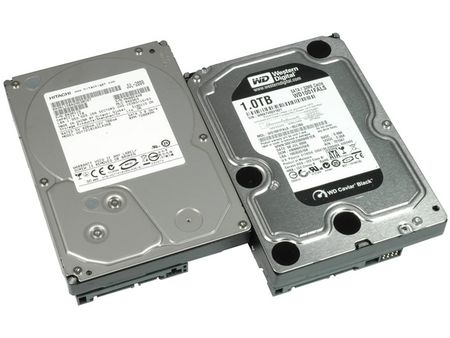1TB Evolves: New Drives, More Speed
Hitachi, WD: 1-TB Drives Revised
The race to terabyte capacity points in the 3.5” desktop space ended almost one and a half years ago. Hitachi was first to market with its Deskstar 7K1000. Samsung had announced its terabyte drive rather early, but WD made it to the shelves next with its Green Power Caviar GP 1 TB drive, followed by Seagate’s Barracuda 7200.11, and then Samsung’s Spinpoint F1.
Although Seagate is about to release its next product generation, which will store a massive 1.5 TB of data, 1 TB drives will soon become the norm for performance desktops, making this segment extremely attractive. That was reason enough for Hitachi and Western Digital to release completely revised products, which aim at claiming the performance and efficiency crowns. Enter Hitachi’s Deskstar 7K1000.B and the Western Digital Caviar Black 1 TB.
More Capacity? Not a Problem!
Seagate’s 1.5 TB drive announcement hit the wires on July 10, but it wasn’t exactly a big surprise to anyone with a little insight into the hard drive market. Thanks to perpendicular magnetic recording, which allows stored bits to be moved closer to each other by magnetizing particles in a vertical orientation, capacities per platter have increased faster than ever before. While Hitachi’s Deskstar 7K1000 was still based on five platters, the WD Caviar GP and Seagate’s Barracuda 7200.11 at 1 TB both utilize four platters. Samsung’s Spinpoint F1 was the only terabyte drive to be based on three platters.
The new Seagate Barracuda 7200.11 will reach its 1.5 TB capacity by writing data onto four platters of roughly 375 GB each. Looking at the three-platter drives by Samsung, as well as the new Hitachi Deskstar 7K1000.B and WD’s Caviar Black GP, which both are three-platter products as well, it is safe to assume that these three competitors could create similar drives if they wanted. However, most of them won’t take this step before the end of the year.
Speed And Efficiency Matter
Clearly, not everyone really needs a terabyte of storage, but there are several other reasons to go for such a drive. First up is the appealing capacity, which is one of the best selling points you can think of. Hence, all of the PC makers will try to fit 1 TB drives into their mainstream products as soon as possible. The second factor is the shrinking price difference between mainstream drives in the 500 GB to 750 GB range, and these terabyte drives. Spending an additional $20-30 usually justifies going for the sexy terabyte capacity point, which should provide sufficient storage space for several years.
Get Tom's Hardware's best news and in-depth reviews, straight to your inbox.
That said, the new drives do not simply represent additional choice in this market. They have undergone substantial revisions to not only increase performance, but also to improve efficiency. Falling cost ensures great price per gigabyte ratios, and the increased energy awareness of the hard drive makers also helps guide the latest generation of 7,200 RPM desktop drives to much-improved performance per watt scores.
B Like Black – Or Like 7K1000.B
The two new drives share a three-platter layout and the same 7,200 RPM rotation speed, but apart from that they show different performance characteristics. The new Hitachi 7K1000.B isn’t a single product in its own family anymore. Rather, Hitachi GST now offers a full lineup at different capacity points.
Western Digital introduced its new drive under the Caviar Black banner, representing enthusiast hard drives, and as the RE3 (RAID Edition 3) for entry-level servers.
Can the new drives beat the impressive throughput of Samsung’s Spinpoint F1? Will there be a new overall winner? Let’s find out.
Current page: Hitachi, WD: 1-TB Drives Revised
Next Page Hitachi Deskstar 7K1000.B 1 TB (HDT721010SLA360)